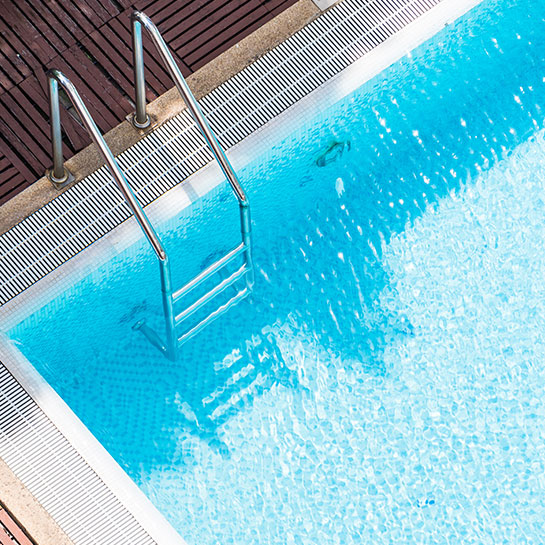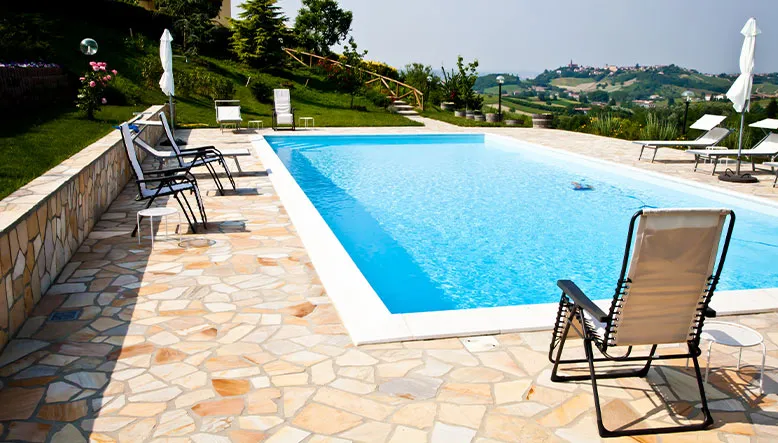If you have a swimming pool already built and you have noticed that it is leaking water, it is very likely that you have wondered what is the best way to waterproof it. And it is natural, because with the passage of time and use, the pool can deteriorate, even when proper maintenance tasks are carried out. Fortunately, you don’t need to build a new one to solve this problem, you just need to apply the right solution to waterproof an already built pool.
Two types of solutions are available to extend the life of your pool: geotextile sheets and preformed PVC membranes. There are often doubts as to which is the better alternative. For this reason, in this content of ParaTuReforma we show you the characteristics and advantages of each of them and provide you with some details to take into account to make the right choice.
Comparison of the methods for waterproofing a swimming pool that has already been built
Leaving aside the importance of having a well waterproofed pool, which is obvious, you should be informed of the characteristics of both materials to renovate your pool and continue using it for a long time in perfect conditions. Deciding between geotextile sheets or PVC membranes will depend on factors such as budget, the finish you prefer or maintenance needs.
Geotextile sheets: Versatile and economical
Geotextile sheets are synthetic materials, usually polyester or polypropylene, which, being flexible, adapt to any shape and size of the pool. For this reason, they are a popular option for waterproofing these spaces in a simple, versatile and affordable way.
One of the advantages of geotextile geotextile sheets is their high durability and strength. As they tolerate wear and tear very well, they are ideal for long-term applications. They are very easy to install and conform perfectly to the surface of any pool.
However, they also have certain drawbacks. On the one hand, although they are durable, it is usually advisable to repair them periodically to ensure their effectiveness. On the other hand, as they are placed over the original coating, the result of the waterproofing is not very aesthetic.
PVC preformed membranes: Efficiency and reliability
PVC membranes are also flexible, as well as resistant to chemicals and the effect of UV rays. They are produced to size at the factory and conform to the pool surface without any problem. The seams are sealed to ensure watertightness when waterproofing an existing pool, forming an effective barrier that prevents any leakage.
Another of the strengths of PVC membranes is their high resistance to all types of elements, which facilitates their maintenance and subsequent repairs, something that is not usually necessary for several years.
On the other hand, the installation cost of these membranes is higher compared to geotextile membranes, due to the material and the specialized labor required. Although you can install them on your own, to ensure that everything is well placed and sealed it is advisable to have it done by professionals.
How to choose the waterproofing method for your pool?
Now that you know, in general terms, the advantages and disadvantages of these methods, it is time to make a decision. But before doing so, it is important to take into account some factors to make the right choice. Specifically, there are 3: the condition of the pool, your budget and aesthetics.

If the pool has a large number of cracks and structural damage, it is advisable to opt for a method that provides the most coverage and reinforcement.
When it comes to budget, don’t just look at the initial price, but also the long-term maintenance costs. Preformed PVC membranes may have a higher price tag, but their durability and lower maintenance can offset the investment.
Consider also the final appearance you want your pool to have after the repair, and the use you plan to give it. If you are looking for a more discreet and aesthetic solution, membranes are a good choice.
How to install geotextile sheeting
To waterproof a pool already constructed with geotextile sheeting, make sure the cracked area is clean and free of burrs that could interfere with the repair. Remove the tiles and apply a layer of hydraulic mortar over the surface. Cut and spread the sheet, making sure it is tight and wrinkle-free. Finally, use masking tape to seal the joints and replace the tiles before filling the pool.
Installation of PVC preformed membranes
If you decide to undertake awaterproofing with PVCmembranes on your own, make sure that the entire surface is clean and free of debris or debris. Apply a specific PVC adhesive all over the pool or in the area to be repaired if you are interested in repairing the cracks. Unfold the membrane and adjust it carefully, avoiding bubbles or folds. Secure all seams and edges with heat welding to ensure complete waterproofing.
Maintenance and aftercare
After waterproofing a pool already built, it is imperative to carry out a proper maintenance plan to enjoy it as long as possible. In the case of geotextile sheets, carry out periodic inspections in order to detect possible wear or damage, and repair any affected area to maintain its integrity.
If you choose PVC membranes, you will need less maintenance. However, from ParaTuReforma we advise you to make a review at least once a year and remove any dirt or accumulation of debris that occurs.
In short, both options offer effective solutions for waterproofing your pool. The choice will differ, to a large extent, depending on factors such as your budget or the time you are willing to invest in maintenance. By making an informed decision, you can enjoy a functional, leak-free pool for many years to come.
And remember that in our online store you have all the materials you need to have your pool in perfect condition. Contact us without obligation.


